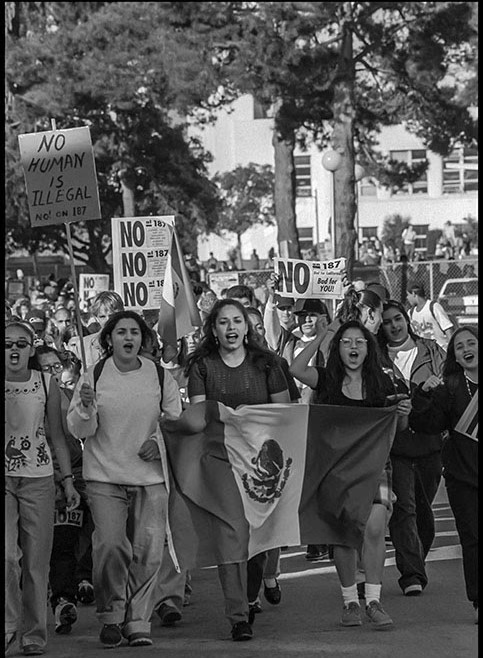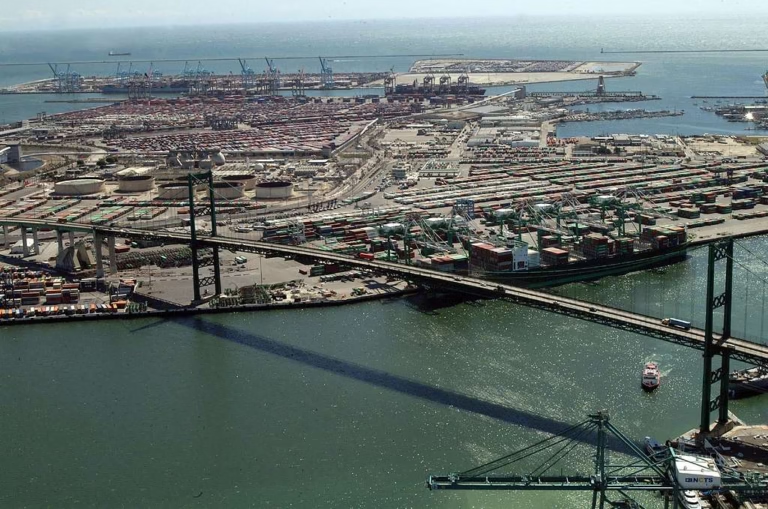Berkeley’s famous leftwing politics was a product of the civil rights and student movements of the 1960s, and students left the local high school campus to join the thousands in San Francisco protesting racism in hiring at the Sheraton Palace Hotel, and later the auto dealerships on Cadillac Row. When student leader Tracy Sims was suspended on their return, the students struck the school to win her reinstatement. Radical photographer Paul Richards took a famous photograph of Sims in a voter registration demonstration, one of the many causes she championed.
That protest tradition continued into the 1990s, when students blew out of class at Berkeley High to fight Proposition 187, which would have made education and health care illegal for undocumented immigrants. That walkout was one of many immigrant rights demonstrations that followed in the years since.
But Berkeley also has a working class history that is much less discussed. In the years after World War 2 it was an industrial city, with factories along the edge of the bay. After the wreckage of deindustrialization of the 1980s and 90s, the biggest one left was the huge Pacific Steel foundry on Second Street. As long as it was up and running, the workers there were militant strikers for better contracts, and supporters of the anti-apartheid movement in South Africa. In the foundry’s final years they fought the plant’s impending closure, and marched against a “silent” immigration raid in which over 200 workers lost their jobs. Today Pacific Steel is an empty shell covered in graffiti, waiting for a developer with deep enough pockets to clean up the contaminated soil beneath it and build condos or biotech labs.
Meanwhile, the city’s working class protests surrounded what became its largest employer, the University of California. Many bitter strikes swept through the campus, finally winning union rights and contracts over the years. The same working class upsurge brought fast food workers into marches down Bancroft Way, part of the national movement for $15 an hour and a union. When the pandemic hit, the workers of the city, especially immigrants and workers of color, made the coffee, dumped the garbage bins, and did the essential tasks that made life possible for everyone else.
Berkeley’s activist students and workers are the real reason why the city’s progressive politics became well known. Their history today is celebrated in the poetry of Rafael Jesus Gonzalez, founder of the Mexican and Chicano Studies program at Laney College and the city’s first poet laureate. In Lompoc Federal Prison for trying to block a test of the MX Missile at Vandenberg Airforce Base, he wrote (https://marshhawkpress.org/rafael-jesus-gonzalez-the-gasp/):
I am here for the unfinished song,
the uncompleted dance,
the healing,
the dreadful fakes of love.
I am here for life
& I will not go away.
This history will be celebrated in an exhibit, “Berkeley’s Latino Community” organized by the Berkeley Historical Society and Museum, starting September 21 at 2pm, at 1931 Center Street. Some of the following photographs are part of the exhibit.
Mexican and Chicano students lead a blowout at Berkeley High School in protest of Proposition 187, which would have prevented undocumented students from going to school and their families from receiving healthcare. Blowing out of classes is a form of protest with a long history at the school.
Before a meeting of the Berkeley City Council activists and public officials protest efforts to end Temporary Protected Status (TPS) and Deferred Action for Childhood Arrivals (DACA) for immigrants.
Rafael Jesus Gonzalez, Berkeley Poet Laureate.
Antoniio Junio, a journeyman molder at Macauley Foundry, learned his trade at the Subic Bay Naval Base in the Philippines.
Workers at Pacific Steel go on strike to win a better union contract.
A protest at Pacific Steel against the threatened closure of the foundry, which led to the loss of hundreds of union jobs, most of which were held by Latino and Black workers. Ignacio Dela Fuente, leader of the Molders Union, and Calvin King, chief union steward at the plant, led the protests.
Workers from Pacific Steel march from City Hall to the foundry on Second Street, protesting the firing of hundreds of workers because of their immigration status. Then-council member Jesse Arreguin was one of many public officials who spoke at the workers’ rally at city hall. Metzli Blanco Castaño, daughter of a fired worker, spoke in front of the plant.
Incarnacion “Chon” Rivera drove a truck picking up recycled trash for the Ecology Center during the coronavirus crisis, an “essential” job.
Martin ran the espresso machine in the first months of the pandemic, when there were no masks, and he made one out of a paper towel.
Latino workers laying asphalt for new paving on Jefferson Street.
A Mexican worker sets tiles in the yard of a Berkeley house.
Fast food workers march down Bancroft Way to protest discrimination against Latinos and demanding better wages.
A march at the University of California to protest injustice against Latino and other blue collar campus workers.
Day laborer Fidel Antonio negotiates with a local gardener on Hearst Street, where many workers wait for jobs. He and other day laborers eat lunch at the Multicultural Instiute, before he goes back to his one-room home.










































